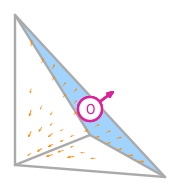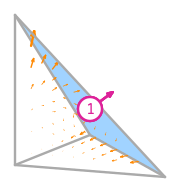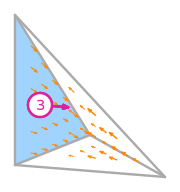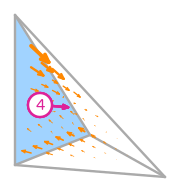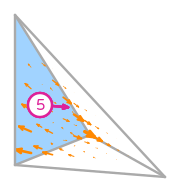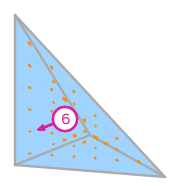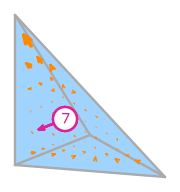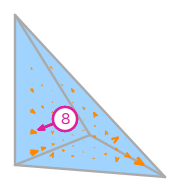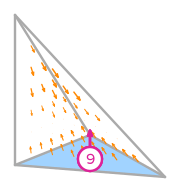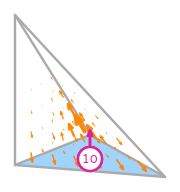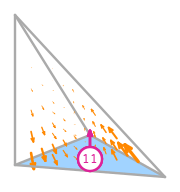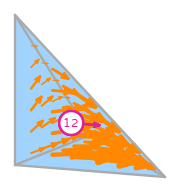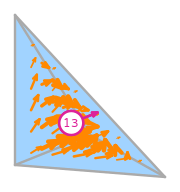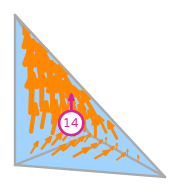an encyclopedia of finite element definitions
Degree 2 Raviart–Thomas on a tetrahedron
◀ Back to Raviart–Thomas definition page
- \(R\) is the reference tetrahedron. The following numbering of the subentities of the reference is used:
- \(\mathcal{V}\) is spanned by: \(\left(\begin{array}{c}\displaystyle 1\\\displaystyle 0\\\displaystyle 0\end{array}\right)\), \(\left(\begin{array}{c}\displaystyle 0\\\displaystyle 1\\\displaystyle 0\end{array}\right)\), \(\left(\begin{array}{c}\displaystyle 0\\\displaystyle 0\\\displaystyle 1\end{array}\right)\), \(\left(\begin{array}{c}\displaystyle x\\\displaystyle 0\\\displaystyle 0\end{array}\right)\), \(\left(\begin{array}{c}\displaystyle 0\\\displaystyle x\\\displaystyle 0\end{array}\right)\), \(\left(\begin{array}{c}\displaystyle 0\\\displaystyle 0\\\displaystyle x\end{array}\right)\), \(\left(\begin{array}{c}\displaystyle y\\\displaystyle 0\\\displaystyle 0\end{array}\right)\), \(\left(\begin{array}{c}\displaystyle 0\\\displaystyle y\\\displaystyle 0\end{array}\right)\), \(\left(\begin{array}{c}\displaystyle 0\\\displaystyle 0\\\displaystyle y\end{array}\right)\), \(\left(\begin{array}{c}\displaystyle z\\\displaystyle 0\\\displaystyle 0\end{array}\right)\), \(\left(\begin{array}{c}\displaystyle 0\\\displaystyle z\\\displaystyle 0\end{array}\right)\), \(\left(\begin{array}{c}\displaystyle 0\\\displaystyle 0\\\displaystyle z\end{array}\right)\), \(\left(\begin{array}{c}\displaystyle x^{2}\\\displaystyle x y\\\displaystyle x z\end{array}\right)\), \(\left(\begin{array}{c}\displaystyle x z\\\displaystyle y z\\\displaystyle z^{2}\end{array}\right)\), \(\left(\begin{array}{c}\displaystyle x y\\\displaystyle y^{2}\\\displaystyle y z\end{array}\right)\)
- \(\mathcal{L}=\{l_0,...,l_{14}\}\)
- Functionals and basis functions:

\(\displaystyle l_{0}:\boldsymbol{v}\mapsto\displaystyle\int_{f_{0}}\boldsymbol{v}\cdot(\sqrt{2})\hat{\boldsymbol{n}}_{0}\)
where \(f_{0}\) is the 0th face;
and \(\hat{\boldsymbol{n}}_{0}\) is the normal to facet 0.
\(\displaystyle \boldsymbol{\phi}_{0} = \left(\begin{array}{c}\displaystyle \sqrt{2} x \left(5 x + 5 y + 5 z - 4\right)\\\displaystyle \sqrt{2} y \left(5 x + 5 y + 5 z - 4\right)\\\displaystyle \sqrt{2} z \left(5 x + 5 y + 5 z - 4\right)\end{array}\right)\)
This DOF is associated with face 0 of the reference element.
where \(f_{0}\) is the 0th face;
and \(\hat{\boldsymbol{n}}_{0}\) is the normal to facet 0.
\(\displaystyle \boldsymbol{\phi}_{0} = \left(\begin{array}{c}\displaystyle \sqrt{2} x \left(5 x + 5 y + 5 z - 4\right)\\\displaystyle \sqrt{2} y \left(5 x + 5 y + 5 z - 4\right)\\\displaystyle \sqrt{2} z \left(5 x + 5 y + 5 z - 4\right)\end{array}\right)\)
This DOF is associated with face 0 of the reference element.
\(\displaystyle l_{1}:\boldsymbol{v}\mapsto\displaystyle\int_{f_{0}}\boldsymbol{v}\cdot(6 s_{1} - 2)\hat{\boldsymbol{n}}_{0}\)
where \(f_{0}\) is the 0th face;
\(\hat{\boldsymbol{n}}_{0}\) is the normal to facet 0;
and \(s_{0},s_{1},s_{2}\) is a parametrisation of \(f_{0}\).
\(\displaystyle \boldsymbol{\phi}_{1} = \left(\begin{array}{c}\displaystyle \frac{x \left(- 5 x - 5 y + 10 z + 1\right)}{2}\\\displaystyle \frac{y \left(- 5 x - 5 y + 10 z + 1\right)}{2}\\\displaystyle \frac{z \left(- 5 x - 5 y + 10 z - 2\right)}{2}\end{array}\right)\)
This DOF is associated with face 0 of the reference element.
where \(f_{0}\) is the 0th face;
\(\hat{\boldsymbol{n}}_{0}\) is the normal to facet 0;
and \(s_{0},s_{1},s_{2}\) is a parametrisation of \(f_{0}\).
\(\displaystyle \boldsymbol{\phi}_{1} = \left(\begin{array}{c}\displaystyle \frac{x \left(- 5 x - 5 y + 10 z + 1\right)}{2}\\\displaystyle \frac{y \left(- 5 x - 5 y + 10 z + 1\right)}{2}\\\displaystyle \frac{z \left(- 5 x - 5 y + 10 z - 2\right)}{2}\end{array}\right)\)
This DOF is associated with face 0 of the reference element.
\(\displaystyle l_{2}:\boldsymbol{v}\mapsto\displaystyle\int_{f_{0}}\boldsymbol{v}\cdot(2 \sqrt{3} \left(2 s_{0} + s_{1} - 1\right))\hat{\boldsymbol{n}}_{0}\)
where \(f_{0}\) is the 0th face;
\(\hat{\boldsymbol{n}}_{0}\) is the normal to facet 0;
and \(s_{0},s_{1},s_{2}\) is a parametrisation of \(f_{0}\).
\(\displaystyle \boldsymbol{\phi}_{2} = \left(\begin{array}{c}\displaystyle \frac{\sqrt{3} x \left(- 5 x + 5 y + 1\right)}{2}\\\displaystyle \frac{\sqrt{3} y \left(- 5 x + 5 y - 1\right)}{2}\\\displaystyle \frac{5 \sqrt{3} z \left(- x + y\right)}{2}\end{array}\right)\)
This DOF is associated with face 0 of the reference element.
where \(f_{0}\) is the 0th face;
\(\hat{\boldsymbol{n}}_{0}\) is the normal to facet 0;
and \(s_{0},s_{1},s_{2}\) is a parametrisation of \(f_{0}\).
\(\displaystyle \boldsymbol{\phi}_{2} = \left(\begin{array}{c}\displaystyle \frac{\sqrt{3} x \left(- 5 x + 5 y + 1\right)}{2}\\\displaystyle \frac{\sqrt{3} y \left(- 5 x + 5 y - 1\right)}{2}\\\displaystyle \frac{5 \sqrt{3} z \left(- x + y\right)}{2}\end{array}\right)\)
This DOF is associated with face 0 of the reference element.
\(\displaystyle l_{3}:\boldsymbol{v}\mapsto\displaystyle\int_{f_{1}}\boldsymbol{v}\cdot(\sqrt{2})\hat{\boldsymbol{n}}_{1}\)
where \(f_{1}\) is the 1st face;
and \(\hat{\boldsymbol{n}}_{1}\) is the normal to facet 1.
\(\displaystyle \boldsymbol{\phi}_{3} = \left(\begin{array}{c}\displaystyle \sqrt{2} \left(5 x^{2} - 6 x + 1\right)\\\displaystyle \sqrt{2} y \left(5 x - 1\right)\\\displaystyle \sqrt{2} z \left(5 x - 1\right)\end{array}\right)\)
This DOF is associated with face 1 of the reference element.
where \(f_{1}\) is the 1st face;
and \(\hat{\boldsymbol{n}}_{1}\) is the normal to facet 1.
\(\displaystyle \boldsymbol{\phi}_{3} = \left(\begin{array}{c}\displaystyle \sqrt{2} \left(5 x^{2} - 6 x + 1\right)\\\displaystyle \sqrt{2} y \left(5 x - 1\right)\\\displaystyle \sqrt{2} z \left(5 x - 1\right)\end{array}\right)\)
This DOF is associated with face 1 of the reference element.
\(\displaystyle l_{4}:\boldsymbol{v}\mapsto\displaystyle\int_{f_{1}}\boldsymbol{v}\cdot(6 s_{1} - 2)\hat{\boldsymbol{n}}_{1}\)
where \(f_{1}\) is the 1st face;
\(\hat{\boldsymbol{n}}_{1}\) is the normal to facet 1;
and \(s_{0},s_{1},s_{2}\) is a parametrisation of \(f_{1}\).
\(\displaystyle \boldsymbol{\phi}_{4} = \left(\begin{array}{c}\displaystyle - \frac{5 x^{2}}{2} - \frac{15 x z}{2} + \frac{9 x}{2} + 6 z - 2\\\displaystyle \frac{y \left(- 5 x - 15 z + 4\right)}{2}\\\displaystyle \frac{z \left(- 5 x - 15 z + 7\right)}{2}\end{array}\right)\)
This DOF is associated with face 1 of the reference element.
where \(f_{1}\) is the 1st face;
\(\hat{\boldsymbol{n}}_{1}\) is the normal to facet 1;
and \(s_{0},s_{1},s_{2}\) is a parametrisation of \(f_{1}\).
\(\displaystyle \boldsymbol{\phi}_{4} = \left(\begin{array}{c}\displaystyle - \frac{5 x^{2}}{2} - \frac{15 x z}{2} + \frac{9 x}{2} + 6 z - 2\\\displaystyle \frac{y \left(- 5 x - 15 z + 4\right)}{2}\\\displaystyle \frac{z \left(- 5 x - 15 z + 7\right)}{2}\end{array}\right)\)
This DOF is associated with face 1 of the reference element.
\(\displaystyle l_{5}:\boldsymbol{v}\mapsto\displaystyle\int_{f_{1}}\boldsymbol{v}\cdot(2 \sqrt{3} \left(2 s_{0} + s_{1} - 1\right))\hat{\boldsymbol{n}}_{1}\)
where \(f_{1}\) is the 1st face;
\(\hat{\boldsymbol{n}}_{1}\) is the normal to facet 1;
and \(s_{0},s_{1},s_{2}\) is a parametrisation of \(f_{1}\).
\(\displaystyle \boldsymbol{\phi}_{5} = \left(\begin{array}{c}\displaystyle \frac{\sqrt{3} \left(- 5 x^{2} - 10 x y - 5 x z + 9 x + 8 y + 4 z - 4\right)}{2}\\\displaystyle \frac{\sqrt{3} y \left(- 5 x - 10 y - 5 z + 6\right)}{2}\\\displaystyle \frac{5 \sqrt{3} z \left(- x - 2 y - z + 1\right)}{2}\end{array}\right)\)
This DOF is associated with face 1 of the reference element.
where \(f_{1}\) is the 1st face;
\(\hat{\boldsymbol{n}}_{1}\) is the normal to facet 1;
and \(s_{0},s_{1},s_{2}\) is a parametrisation of \(f_{1}\).
\(\displaystyle \boldsymbol{\phi}_{5} = \left(\begin{array}{c}\displaystyle \frac{\sqrt{3} \left(- 5 x^{2} - 10 x y - 5 x z + 9 x + 8 y + 4 z - 4\right)}{2}\\\displaystyle \frac{\sqrt{3} y \left(- 5 x - 10 y - 5 z + 6\right)}{2}\\\displaystyle \frac{5 \sqrt{3} z \left(- x - 2 y - z + 1\right)}{2}\end{array}\right)\)
This DOF is associated with face 1 of the reference element.
\(\displaystyle l_{6}:\boldsymbol{v}\mapsto\displaystyle\int_{f_{2}}\boldsymbol{v}\cdot(\sqrt{2})\hat{\boldsymbol{n}}_{2}\)
where \(f_{2}\) is the 2nd face;
and \(\hat{\boldsymbol{n}}_{2}\) is the normal to facet 2.
\(\displaystyle \boldsymbol{\phi}_{6} = \left(\begin{array}{c}\displaystyle \sqrt{2} x \left(1 - 5 y\right)\\\displaystyle \sqrt{2} \left(- 5 y^{2} + 6 y - 1\right)\\\displaystyle \sqrt{2} z \left(1 - 5 y\right)\end{array}\right)\)
This DOF is associated with face 2 of the reference element.
where \(f_{2}\) is the 2nd face;
and \(\hat{\boldsymbol{n}}_{2}\) is the normal to facet 2.
\(\displaystyle \boldsymbol{\phi}_{6} = \left(\begin{array}{c}\displaystyle \sqrt{2} x \left(1 - 5 y\right)\\\displaystyle \sqrt{2} \left(- 5 y^{2} + 6 y - 1\right)\\\displaystyle \sqrt{2} z \left(1 - 5 y\right)\end{array}\right)\)
This DOF is associated with face 2 of the reference element.
\(\displaystyle l_{7}:\boldsymbol{v}\mapsto\displaystyle\int_{f_{2}}\boldsymbol{v}\cdot(6 s_{1} - 2)\hat{\boldsymbol{n}}_{2}\)
where \(f_{2}\) is the 2nd face;
\(\hat{\boldsymbol{n}}_{2}\) is the normal to facet 2;
and \(s_{0},s_{1},s_{2}\) is a parametrisation of \(f_{2}\).
\(\displaystyle \boldsymbol{\phi}_{7} = \left(\begin{array}{c}\displaystyle \frac{x \left(5 y + 15 z - 4\right)}{2}\\\displaystyle \frac{5 y^{2}}{2} + \frac{15 y z}{2} - \frac{9 y}{2} - 6 z + 2\\\displaystyle \frac{z \left(5 y + 15 z - 7\right)}{2}\end{array}\right)\)
This DOF is associated with face 2 of the reference element.
where \(f_{2}\) is the 2nd face;
\(\hat{\boldsymbol{n}}_{2}\) is the normal to facet 2;
and \(s_{0},s_{1},s_{2}\) is a parametrisation of \(f_{2}\).
\(\displaystyle \boldsymbol{\phi}_{7} = \left(\begin{array}{c}\displaystyle \frac{x \left(5 y + 15 z - 4\right)}{2}\\\displaystyle \frac{5 y^{2}}{2} + \frac{15 y z}{2} - \frac{9 y}{2} - 6 z + 2\\\displaystyle \frac{z \left(5 y + 15 z - 7\right)}{2}\end{array}\right)\)
This DOF is associated with face 2 of the reference element.
\(\displaystyle l_{8}:\boldsymbol{v}\mapsto\displaystyle\int_{f_{2}}\boldsymbol{v}\cdot(2 \sqrt{3} \left(2 s_{0} + s_{1} - 1\right))\hat{\boldsymbol{n}}_{2}\)
where \(f_{2}\) is the 2nd face;
\(\hat{\boldsymbol{n}}_{2}\) is the normal to facet 2;
and \(s_{0},s_{1},s_{2}\) is a parametrisation of \(f_{2}\).
\(\displaystyle \boldsymbol{\phi}_{8} = \left(\begin{array}{c}\displaystyle \frac{\sqrt{3} x \left(10 x + 5 y + 5 z - 6\right)}{2}\\\displaystyle \frac{\sqrt{3} \left(10 x y - 8 x + 5 y^{2} + 5 y z - 9 y - 4 z + 4\right)}{2}\\\displaystyle \frac{5 \sqrt{3} z \left(2 x + y + z - 1\right)}{2}\end{array}\right)\)
This DOF is associated with face 2 of the reference element.
where \(f_{2}\) is the 2nd face;
\(\hat{\boldsymbol{n}}_{2}\) is the normal to facet 2;
and \(s_{0},s_{1},s_{2}\) is a parametrisation of \(f_{2}\).
\(\displaystyle \boldsymbol{\phi}_{8} = \left(\begin{array}{c}\displaystyle \frac{\sqrt{3} x \left(10 x + 5 y + 5 z - 6\right)}{2}\\\displaystyle \frac{\sqrt{3} \left(10 x y - 8 x + 5 y^{2} + 5 y z - 9 y - 4 z + 4\right)}{2}\\\displaystyle \frac{5 \sqrt{3} z \left(2 x + y + z - 1\right)}{2}\end{array}\right)\)
This DOF is associated with face 2 of the reference element.
\(\displaystyle l_{9}:\boldsymbol{v}\mapsto\displaystyle\int_{f_{3}}\boldsymbol{v}\cdot(\sqrt{2})\hat{\boldsymbol{n}}_{3}\)
where \(f_{3}\) is the 3rd face;
and \(\hat{\boldsymbol{n}}_{3}\) is the normal to facet 3.
\(\displaystyle \boldsymbol{\phi}_{9} = \left(\begin{array}{c}\displaystyle \sqrt{2} x \left(5 z - 1\right)\\\displaystyle \sqrt{2} y \left(5 z - 1\right)\\\displaystyle \sqrt{2} \left(5 z^{2} - 6 z + 1\right)\end{array}\right)\)
This DOF is associated with face 3 of the reference element.
where \(f_{3}\) is the 3rd face;
and \(\hat{\boldsymbol{n}}_{3}\) is the normal to facet 3.
\(\displaystyle \boldsymbol{\phi}_{9} = \left(\begin{array}{c}\displaystyle \sqrt{2} x \left(5 z - 1\right)\\\displaystyle \sqrt{2} y \left(5 z - 1\right)\\\displaystyle \sqrt{2} \left(5 z^{2} - 6 z + 1\right)\end{array}\right)\)
This DOF is associated with face 3 of the reference element.
\(\displaystyle l_{10}:\boldsymbol{v}\mapsto\displaystyle\int_{f_{3}}\boldsymbol{v}\cdot(6 s_{1} - 2)\hat{\boldsymbol{n}}_{3}\)
where \(f_{3}\) is the 3rd face;
\(\hat{\boldsymbol{n}}_{3}\) is the normal to facet 3;
and \(s_{0},s_{1},s_{2}\) is a parametrisation of \(f_{3}\).
\(\displaystyle \boldsymbol{\phi}_{10} = \left(\begin{array}{c}\displaystyle \frac{x \left(- 15 y - 5 z + 4\right)}{2}\\\displaystyle \frac{y \left(- 15 y - 5 z + 7\right)}{2}\\\displaystyle - \frac{15 y z}{2} + 6 y - \frac{5 z^{2}}{2} + \frac{9 z}{2} - 2\end{array}\right)\)
This DOF is associated with face 3 of the reference element.
where \(f_{3}\) is the 3rd face;
\(\hat{\boldsymbol{n}}_{3}\) is the normal to facet 3;
and \(s_{0},s_{1},s_{2}\) is a parametrisation of \(f_{3}\).
\(\displaystyle \boldsymbol{\phi}_{10} = \left(\begin{array}{c}\displaystyle \frac{x \left(- 15 y - 5 z + 4\right)}{2}\\\displaystyle \frac{y \left(- 15 y - 5 z + 7\right)}{2}\\\displaystyle - \frac{15 y z}{2} + 6 y - \frac{5 z^{2}}{2} + \frac{9 z}{2} - 2\end{array}\right)\)
This DOF is associated with face 3 of the reference element.
\(\displaystyle l_{11}:\boldsymbol{v}\mapsto\displaystyle\int_{f_{3}}\boldsymbol{v}\cdot(2 \sqrt{3} \left(2 s_{0} + s_{1} - 1\right))\hat{\boldsymbol{n}}_{3}\)
where \(f_{3}\) is the 3rd face;
\(\hat{\boldsymbol{n}}_{3}\) is the normal to facet 3;
and \(s_{0},s_{1},s_{2}\) is a parametrisation of \(f_{3}\).
\(\displaystyle \boldsymbol{\phi}_{11} = \left(\begin{array}{c}\displaystyle \frac{\sqrt{3} x \left(- 10 x - 5 y - 5 z + 6\right)}{2}\\\displaystyle \frac{5 \sqrt{3} y \left(- 2 x - y - z + 1\right)}{2}\\\displaystyle \frac{\sqrt{3} \left(- 10 x z + 8 x - 5 y z + 4 y - 5 z^{2} + 9 z - 4\right)}{2}\end{array}\right)\)
This DOF is associated with face 3 of the reference element.
where \(f_{3}\) is the 3rd face;
\(\hat{\boldsymbol{n}}_{3}\) is the normal to facet 3;
and \(s_{0},s_{1},s_{2}\) is a parametrisation of \(f_{3}\).
\(\displaystyle \boldsymbol{\phi}_{11} = \left(\begin{array}{c}\displaystyle \frac{\sqrt{3} x \left(- 10 x - 5 y - 5 z + 6\right)}{2}\\\displaystyle \frac{5 \sqrt{3} y \left(- 2 x - y - z + 1\right)}{2}\\\displaystyle \frac{\sqrt{3} \left(- 10 x z + 8 x - 5 y z + 4 y - 5 z^{2} + 9 z - 4\right)}{2}\end{array}\right)\)
This DOF is associated with face 3 of the reference element.
\(\displaystyle l_{12}:\boldsymbol{v}\mapsto\displaystyle\int_{R}\boldsymbol{v}\cdot\left(\begin{array}{c}\sqrt{6}\\0\\0\end{array}\right)\)
where \(R\) is the reference element.
\(\displaystyle \boldsymbol{\phi}_{12} = \left(\begin{array}{c}\displaystyle 5 \sqrt{6} x \left(- 2 x - y - z + 2\right)\\\displaystyle 5 \sqrt{6} y \left(- 2 x - y - z + 1\right)\\\displaystyle 5 \sqrt{6} z \left(- 2 x - y - z + 1\right)\end{array}\right)\)
This DOF is associated with volume 0 of the reference element.
where \(R\) is the reference element.
\(\displaystyle \boldsymbol{\phi}_{12} = \left(\begin{array}{c}\displaystyle 5 \sqrt{6} x \left(- 2 x - y - z + 2\right)\\\displaystyle 5 \sqrt{6} y \left(- 2 x - y - z + 1\right)\\\displaystyle 5 \sqrt{6} z \left(- 2 x - y - z + 1\right)\end{array}\right)\)
This DOF is associated with volume 0 of the reference element.
\(\displaystyle l_{13}:\boldsymbol{v}\mapsto\displaystyle\int_{R}\boldsymbol{v}\cdot\left(\begin{array}{c}0\\\sqrt{6}\\0\end{array}\right)\)
where \(R\) is the reference element.
\(\displaystyle \boldsymbol{\phi}_{13} = \left(\begin{array}{c}\displaystyle 5 \sqrt{6} x \left(- x - 2 y - z + 1\right)\\\displaystyle 5 \sqrt{6} y \left(- x - 2 y - z + 2\right)\\\displaystyle 5 \sqrt{6} z \left(- x - 2 y - z + 1\right)\end{array}\right)\)
This DOF is associated with volume 0 of the reference element.
where \(R\) is the reference element.
\(\displaystyle \boldsymbol{\phi}_{13} = \left(\begin{array}{c}\displaystyle 5 \sqrt{6} x \left(- x - 2 y - z + 1\right)\\\displaystyle 5 \sqrt{6} y \left(- x - 2 y - z + 2\right)\\\displaystyle 5 \sqrt{6} z \left(- x - 2 y - z + 1\right)\end{array}\right)\)
This DOF is associated with volume 0 of the reference element.
\(\displaystyle l_{14}:\boldsymbol{v}\mapsto\displaystyle\int_{R}\boldsymbol{v}\cdot\left(\begin{array}{c}0\\0\\\sqrt{6}\end{array}\right)\)
where \(R\) is the reference element.
\(\displaystyle \boldsymbol{\phi}_{14} = \left(\begin{array}{c}\displaystyle 5 \sqrt{6} x \left(- x - y - 2 z + 1\right)\\\displaystyle 5 \sqrt{6} y \left(- x - y - 2 z + 1\right)\\\displaystyle 5 \sqrt{6} z \left(- x - y - 2 z + 2\right)\end{array}\right)\)
This DOF is associated with volume 0 of the reference element.
where \(R\) is the reference element.
\(\displaystyle \boldsymbol{\phi}_{14} = \left(\begin{array}{c}\displaystyle 5 \sqrt{6} x \left(- x - y - 2 z + 1\right)\\\displaystyle 5 \sqrt{6} y \left(- x - y - 2 z + 1\right)\\\displaystyle 5 \sqrt{6} z \left(- x - y - 2 z + 2\right)\end{array}\right)\)
This DOF is associated with volume 0 of the reference element.
